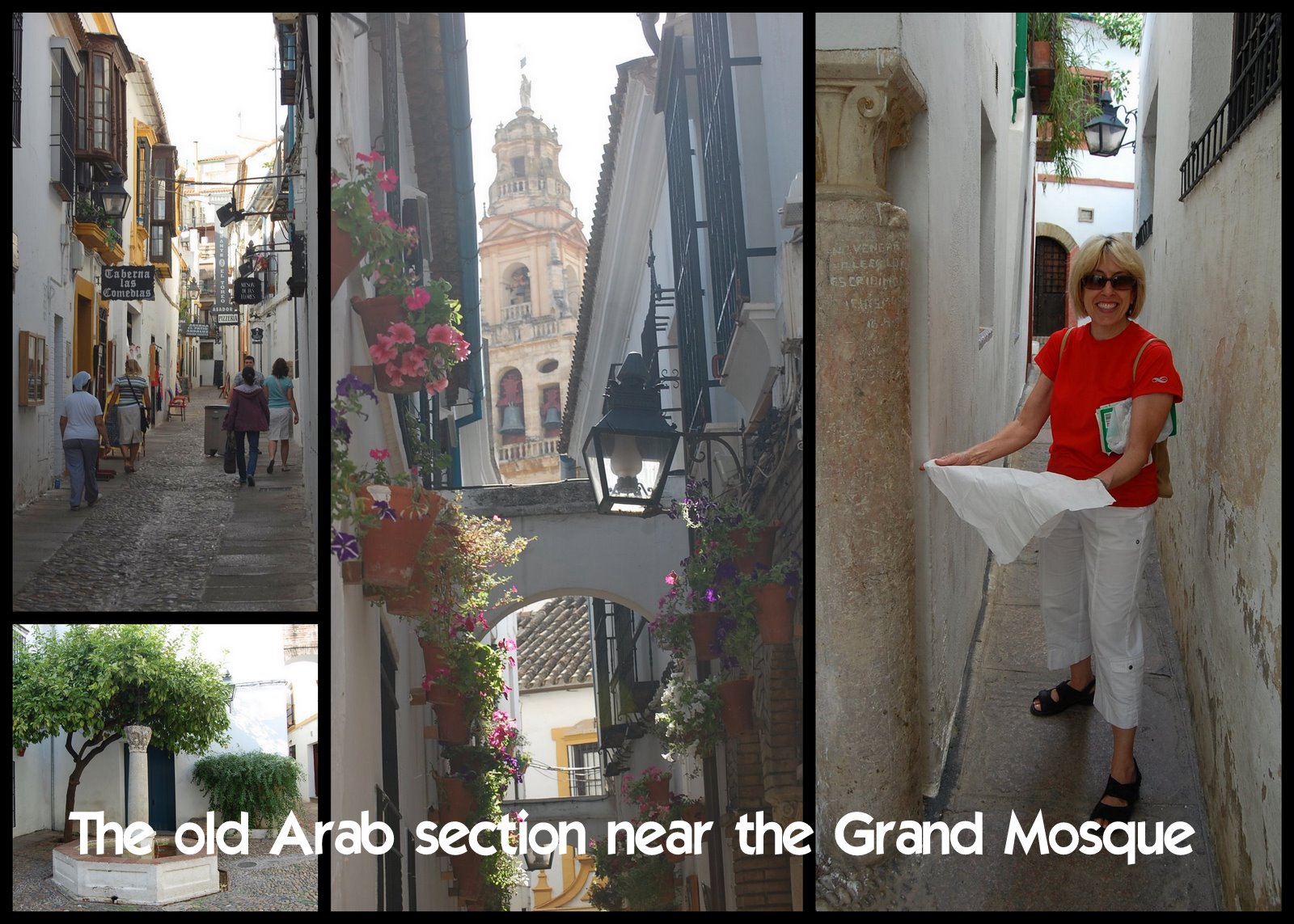
No surprise, the Arab quarter clings to its mosque even though it has been baptized with wedding-cake bell towers by the famous Ruiz architect family we'll discuss later (see photo below left). While the arches (below right) look authentic, Córdoba's mayor added them to attract tourists during the 1950s. How these flowers get sufficient sun in these narrow alleys (Callejas) is beyond me. What we see here is the Arab section generic dead end: a narrow whitewashed calleja bristling with cast iron and clay pots. In an unholy compromise between tradition and convenience, the arch has been added for the tourists and the electric wires for the residents.
But even the most narrow callejas lead to squares where the neighbors gathered around their water supply. The Moor's brought water to the Mosque and then piped it down to the squares in this area.
If a Callejas (alley) is too big for you, we have pictured below the even narrower Callejita de Panuelo (nicknamed after the handkerchief which, when held diagonally as by our model in the picture below, extends its width.) Its real name is Calle Pedro Jimènez. We visited here before lunch as I may not have fit through this alleyway afterwards. Note the pillar, most likely expropriated from an earlier monument, used here to prop up the corner of the building. This is a common architectural element of the whitewashed towns of Andalusia.
Walking through the Gothic facade, we encounter a courtyard which is everything the portal is not: spacious but simple with plain brick arches forming a double arcaded space that once held the ablutions room during mosque days
One side of the courtyard still holds remnants of the Alcazar (fort) of the Caliphs from the 10th century).
After the conquest, the cathedral chapter formed the Brotherhood of San Sebastian to provide care for the sick and demented. In the early 16th century, they began to take in the homeless children abandoned in Cordóba’s streets. At first they used one of the side rooms off the mosque’s Patio de los Naranjos before tasking Hernán Ruiz with creating this orphanage, called the Hospital de San Sebastián. The wealthy Juan Fernandez de Cordova, feeling guilty over his early life, paid the bill. (We don’t know what he was repenting from, but he was the one who brought the Jesuits to Cordoba earlier.)
Returning to the front of the building, we explore the former chapel area, now housing Córdoba’s tourist office.
Stepping back into the street and looking south past the long wall of the mosque/cathedral on our left and towards Rio Guadalquivir, we catch sight (below left) of the most significant of the many statues to Saint Rafael in this town. In the pre-WHO 16th century, Rafael appointed himself custodian after saving Córdoba from the plague.
When a statue is raised on high by a column, it's called a Triunfo (Triumph). This is the grandest in town, erected in 1736 by the cathedral chapter which was probably a bit envious of the many Rafael statues raised by competing religious groups such as the Jesuits. The site is just south of the mosque/cathedral kitty-corner to the grand southern gate that we will see a bit later.
The Triunfo project started by disinterring human remains from a nearby hospital, replacing them with a cascading Italian fountain which never worked right and was abandoned. This was replaced by what appears to be a hill of carved statuary of angel and animal (above left), topped by a large cylinder. Rising above all this is a pillar atop which the serene Rafael smiles (apparently fishless as we shall see) in marble above the town he saved.
Next, come with us while we visit the Arab baths, scene of a few assisinations of the Caliphs during Córdoba's turbulent regime changes. Join us by clicking here.|
Please join us in the following slide show to give Córdoba the viewing it deserves by clicking here. |
|
Geek and Legal StuffPlease allow JavaScript to enable word definitions. This page has been tested in Internet Explorer 8.0, Firefox 3.0, and Google Chrome 1.0. Created on June 15, 2009 |
 |